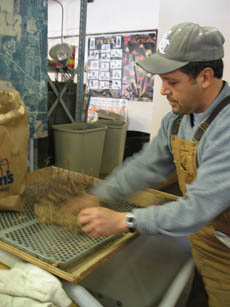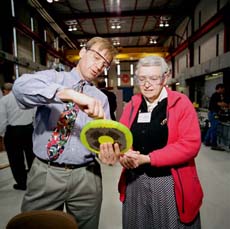|
Wed., January 31
11:00 a.m. Academic Lecture Series - 1 West
Speaker: E. Lunghi, Fermilab
Title: Course 1, Part 4 - Introduction to Flavor Physics In and
Beyond the Standard Model
3:30 p.m.
DIRECTOR'S COFFEE BREAK -
2nd Flr X-Over
4:00 p.m.
Fermilab Colloquium -
1 West
Speaker: P. Emma, Stanford Linear Accelerator Center
Title: The Linac Coherent Light Source Project at SLAC
THERE WILL BE NO FERMILAB ILC R&D MEETING THIS WEEK
Thurs., February 1
1:30 p.m.
Particle Astrophysics Seminar - (NOTE LOCATION)
Comitium
Speaker: O. Dore, CITA
Title: Cosmological Microwave Background: The Next Chapter
2:30 p.m.
Theoretical Physics Seminar -
Curia II
Speaker: R. Britto, University of Amsterdam
Title: Constructing One-Loop Amplitudes
3:30 p.m.
DIRECTOR'S COFFEE BREAK -
2nd Flr X-Over
4:00 p.m.
Accelerator Physics and Technology Seminar -
1 West
Speaker: N. Eddy, Fermilab
Title: Beam Control and Monitoring with FPGA-Based Electronics:
Status and Perspectives
THERE WILL BE NO ALCPG ILC PHYSICS AND DETECTOR
SEMINAR THIS WEEK
Click here for NALCAL,
a weekly calendar with links to additional information. |
Wednesday, January 31
-Vegetable Beef
-Crab Cakes
-Almond Crusted Sole
-Country Fried Steak with Pepper Gravy
-Beef and Cheddar Panini with Sauteed Onions
-Assorted Slice Pizza
-Cavatappi Pasta with Italian Sausage and Tomato Ragu
Wilson Hall Cafe Menu |
|
Wednesday, January 31
Lunch
Chili Rellenos
Rice and Beans
Pico de Gallo
Cold Lime Soufflé with Cookies
Thursday, February 1
Dinner
Beef Fondue with Assortment of Sauces
Salad of Greens with Pears and Shaved Parmesan
Chocolate Almond Mousse in Nut Cups
Chez Leon Menu
Call x4598 to make your reservation. |
|
|
Little seeds make deep roots

Martin Valenzuela sifts seeds from leaves and stems to get ready for planting season.
It's Monday afternoon, and senior groundskeepers Martin Valenzuela and Cleo Garcia are hunched over buckets of dried plants, shaking buds and filtering stems through what look like flour sifters. After rubbing tiny seeds under blocks of sandpaper to "scarify" them, Valenzuela places one under a magnifying glass to reveal a fresh, yellowish kernel peeking out from a brown husk. The little seed has a big name: 'Gentian puberulenta.'
But other plants in Fermilab's seed-drying room have names that are not so cryptic. "This one is rattlesnake master," says Valenzuela, pulling out a dried, long stemmed plant with little pods on top. "Natives used it to cure or treat snakebites." He points to a plastic tub of seeds with fluffy outcroppings, reminiscent of dandelions. "You can see how nature was able to move seeds before humans moved dirt around," he says. These fluffy seeds will grow plants that attract butterflies.
Valenzuela started his career at Fermilab 25 years ago, working in the kitchen. He says he always wanted to work on prairie restoration, and he finds similarities between his newer job and his old one: "We do our seed mixes like cooks," he says, pointing to six enormous drawers of seed mixtures labeled "Woodlands," "Savannah," "Wetlands," "Dry Prairie," "Mesic Prairie" and "Wet Prairie." Each drawer has a unique, 35-year-old recipe of seeds for each type of land at Fermilab.
Most important are the legumes, which have nitrogen-fixing bacteria. They bring nitrogen from the atmosphere into the soil, transforming it into compounds that are useful for other plant life. Beyond legumes, the other prairie plants have deep roots that harness carbon and water in the subsoil, cutting down on atmospheric carbon dioxide and keeping the earth healthy and moist. "Some of these seeds will grow plants with roots that are 20 feet deep," said Valenzuela.
--Siri Steiner

Butterfly weed seeds.

Martin Valenzuela and Cleo Garcia hold 8 pounds of gentian seed, collected during last fall's prairie harvest. Outside suppliers charge $875 per pound for this type of seed.
|
From Science,
January 30, 2007:
U.S. House Throws Science a Lifeline
Tomorrow, the U.S. House of Representatives is expected to pass a belated 2007 spending bill that treats research much more favorably than science advocates had dared hoped--and avoids budget cuts that many had feared. While freezing spending across most of the federal government, the legislation gives a shot in the arm to research at the National Science Foundation (NSF), the Department of Energy (DOE), and the National Institute of Standards and Technology (NIST).
"I think it's a very good sign that they will be supportive of competitiveness and innovation," says Pier Oddone, director of DOE's Fermi National Accelerator Laboratory (Fermilab) in Batavia, Illinois, which may have dodged a budget-induced work slowdown. "I understand that they can't do everything we would like to do [this year], but I am appreciative of the support they have shown so far."
Read More |
|
|
The future of precision

This column is written by PPD Head Jim Strait. Above, Strait is showing a
cross-section of an LHC quadrupole magnet to Millie Dresselhaus, former
Director of the Office of Science, at the Industrial Center in 2000. Strait
was then serving as project director for the US LHC accelerator effort.
The ILC physics program will be as much at the "precision frontier" as the energy frontier, and it is driving the development of many new detector technologies and data analysis techniques. Fermilab is ramping up its own development effort and its support for the wider particle physics community.
The silicon vertex and tracking detectors for the ILC must be dramatically thinner than those in existing experiments (for example, CDF, DZero or CMS). This thinness will minimize the scattering of particles in the detectors, which would otherwise degrade the measurements. The ILC experiments hope to measure the energy of jets using a technique called "particle flow," in which the energy of charged particles is measured in the tracker, and the calorimeter is used only to measure the energy of neutral particles. These calorimeters require unprecedented spatial resolution. An alternate method, called "dual readout," might be able to measure the total energy of jets with similar accuracy, while requiring a lower spatial resolution.
The world-wide ILC community is pursuing a variety of technologies, with as wide a variety of acronyms: SOI, MAPS, HAPS, FAPS, 3D, CPCCD, FPCCD, DEPFET, ISIS, SiPM, to name just a few. (And I even know what some of them stand for!) Fermilab is stepping forward to support this effort, and to lead it in areas where we have special capabilities. For example, PPD physicists and engineers are leading efforts on selected technologies for
vertex detectors they believe have the most promise to achieve the demanding ILC requirements. We are also exploring which of the numerous calorimeter technologies we find most promising.
Fermilab has recently upgraded its test beam facility to offer world-leading support for determining the viability of these new technologies for the ILC. During the well-received ILC Detector Test Beam work shop at Fermilab two weeks ago, more than 120 researchers from universities and laboratories around the world convened to begin developing a roadmap for detector R&D. They also discussed strengthening test beam performance, meeting the requirements of the ILC, and keeping detector R&D on a timescale to coincide with completion of the ILC accelerator project. We are looking forward to an engaging beam test program with the world community.
|
Filming in a blue convertible
Dear FT:
I really enjoyed yesterday's article by Christine Buckley about
the French documentary. The story became even more interesting when I found out that Jackie Coleman, who works in my
office, drove the French cameraman around the site in her
little blue convertible MG sports car. He actually did the filming while
sitting on top of the seat! How cool is that!
Jackie never expected to see
the film since she knew it was going to be shown in France. But now, 34 years
later, she finally has the chance.
Thanks,
Sue Grommes
Directorate
|
Celebrating Sharon Austin
Sharon Austin, a Fermilab employee since 1981, will retire January 31, 2007.
Austin has contributed to a number of projects at the lab,
including Tevatron spool production, SiDet, e-cool and high-field magnet R&D.
Prior to these assignments, she was part of Detector Support in the Physics Section
and Detector R&D in the Particle Detector Group.
An informal retirement party will take place today, January 31 at 3:00 p.m. in Lab 6; feel free to stop by to say goodbye.
|
|
Print Server out tomorrow morning
The site-wide print server, FNPRT, will be inaccessible due to maintenance between 7:00-8:00am, Thursday, February 1. Please plan accordingly.
Upcoming Activities |
|